Wine Decanting 101: When, Why, and How to Do It Right
When done right, decanting can take your wine drinking experience to a whole new level.
But, what does decanting do to your wine? Should all wines be decanted? What’s the right way to do it?
Let’s take the mystery out of this ritual!
In this article, explore all about decanting wine, why you should do it, and which wines to decant. We’ll cover when and how to decant your favorite wines, how to serve decanted wine, and more.
And, if you want to build a wine collection, we’ll show you an easy way to buy collectible wines.
Further reading
- If you want to get ahead in the wine investment world, start with this Ultimate Guide to Wine Investing.
- Also discover some of the most Elegant Dry Red Wines and luscious Dry White Wines.
What is Wine Decanting?
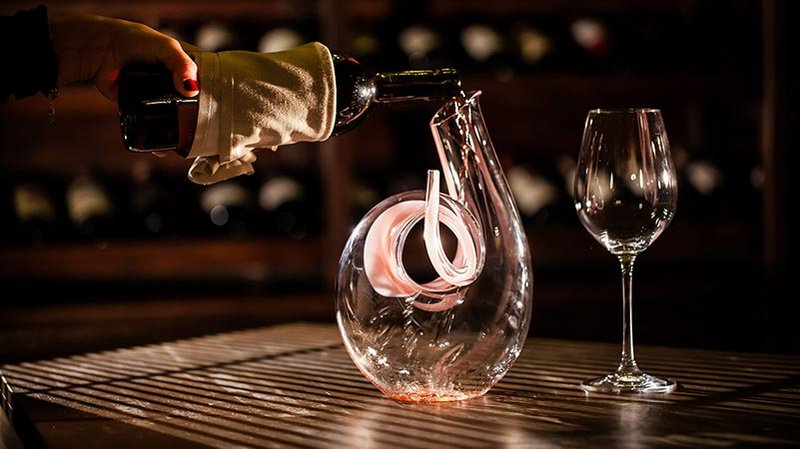
Wine decanting is all about pouring your wine from the bottle into a different vessel. You do this mainly to separate the sediment at the bottom of the bottle from the clear wine, and to aerate the wine before drinking it.
Did you know you can double decant your wine as well?
Double decanting means decanting the wine into a vessel and then pouring it back into the bottle. Double decanting is usually done for the more expensive wines at restaurants and when you want to show the original bottle to your guests.
Besides adding flair to your wine service ritual, decanting also improves the wine taste and qualities.
What does a wine decanting vessel look like?
They’re made of glass and are shaped like swan, duck, cornett, or more traditional bowl-shaped vessels.
So, what are the advantages of wine decanting?
Benefits of Decanting Wine

There are five benefits of decanting your wine:
- Sediment removal: Sediment is the solid material that settles down at the bottom of the bottle as the wine ages. It is most common in older red wine bottles and vintage port.
It’s not harmful to you, but it usually tastes bitter and unpleasant. Sediment might also make some of the wine’s flavors taste duller. Slowly pouring your wine in a decanter will help you get only the clear liquid without any sediment intrusion.
- Aeration: When you pour the wine into a decanter, the liquid is introduced to oxygen, and various changes occur. Oxidation allows the wine’s aroma and flavor to open up making it a great tasting experience for wine drinkers!
Some wines with harsher tannins also benefit from aeration since oxygen helps their tannins soften, making the wine more pleasant to drink.
Some other wines might have a distinct smell of struck match or rotten eggs upon bottle opening, which disappear once the wine is exposed to oxygen.
- Improving reduced white and rose wines: (Reduced wine is that which hasn’t been exposed to enough oxygen and develops smells of eggs and sulfur.)
Even though decanting is most beneficial for red wines, some reduced white and rose wines can benefit from it too. Wines that have lost their initial liveliness and flavors improve after a short decanting period.
- Bringing wine to the proper serving temperature: If your wine has been stored at a lower temperature, the easiest way to warm it up a bit is by decanting it.
- Removing broken cork pieces from the wine: If you notice that the cork has broken, slowly pouring the wine in a decanter will retain the cork pieces in the neck of the bottle.
However, if the pieces are very small, you can pour the wine in the decanter through an extra filter (like a strainer) to avoid getting any particles in your glass.
Now:
Should you decant only red wines? What about rose, white and sparkling wine?
And is it better to decant older or younger vintages?
Which Wines Need Decanting?
Here’s how wine professionals approach decanting when it comes to different wines:
1. Red Wine
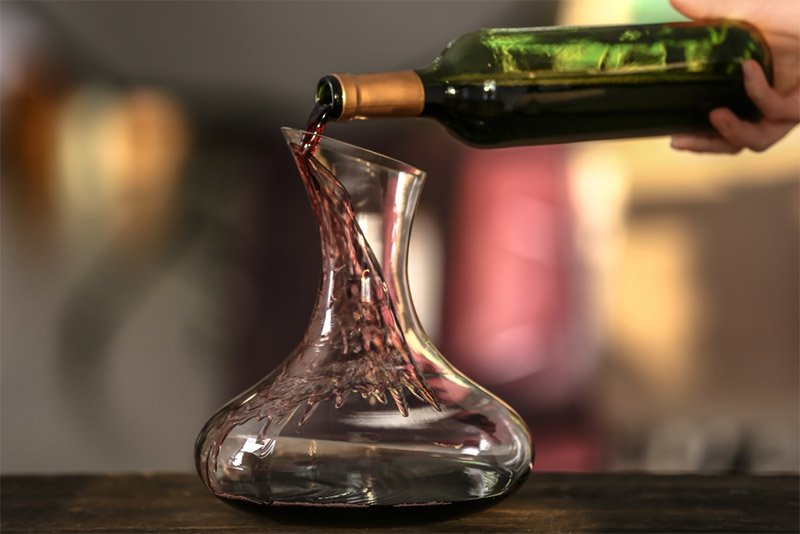
Red wine contains the most sediment and has higher tannin levels than other wine styles. That’s why decanting red wine is highly recommended.
The decanting time will depend on:
- The wine style (we’ll take a look at the perfect decanting time for each red wine style in a bit), and
- The vintage (an older bottle of mature wine usually needs a shorter decanting period.)
For example, elegant reds like Pinot Noir and Merlot are approachable, and you can decant them just for a few minutes before serving.
But, young red wine with high tannin levels will soften up and open up its aroma bouquet after a longer period of decanting. This includes wines like:
2. White and Rose Wine

White wine and Rose rarely need decanting, and if they do, it’s usually no more than 30 minutes before serving.
These are the instances when your whites and rose wines benefit from decanting:
- Reduced roses and white wines open up after being poured in the decanter.
- Some aged wine vintages like white Burgundy display enhanced aromas during wine tasting after a short decanting period.
- White wine that tastes too acidic and awkward (volatile acidity), softens after a short breathing period in the decanter.
3. Sparkling Wine
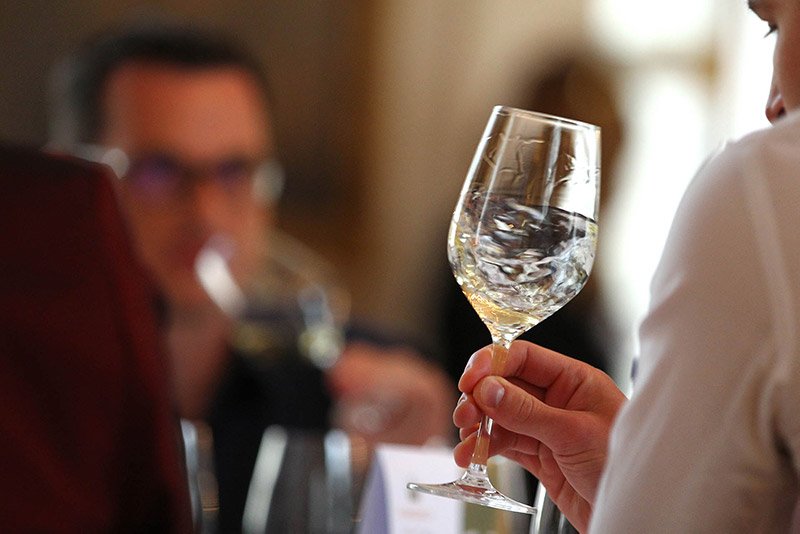
Sparkling wine is the only wine that does not directly benefit from decanting.
However, in recent years, it has become trendy to decant Champagne, especially some of the older vintages.
Why?
After aging, Champagne tends to develop a more complex and layered aroma profile. In the decanter, these aroma compounds open up fully, and you get an even more enjoyable bubbly.
Decanting for about 15 minutes also tones down the effervescence, so if you’re not a fan of the harsh bubbles, decanting might be the solution for you.
4. Old Wine vs. Young Wine
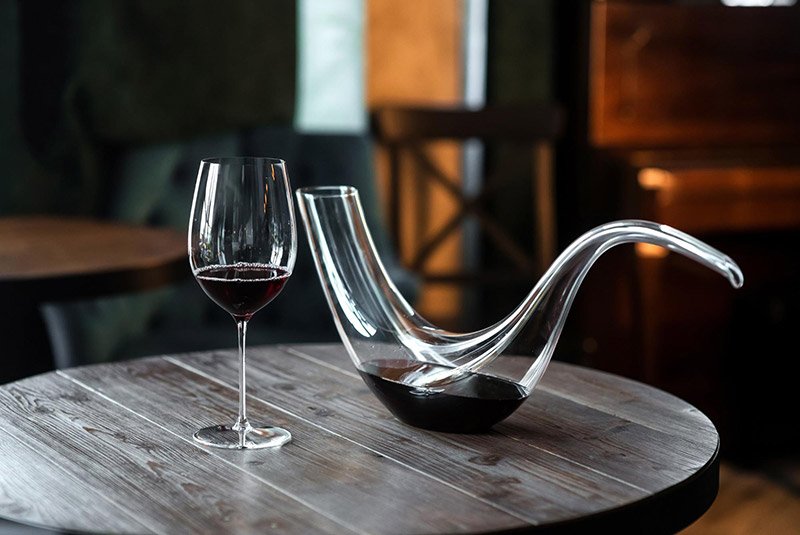
Older wine needs only a short decanting period (15-30 minutes.) That’s because aged wine is more fragile, with a more refined structure and softer tannins.
If you have an older wine bottle, it might even not need decanting - just pour a bit of the mature wine into your glass straight from the bottle and see if you like its taste.
Young vintages, however, are more robust and tannic, and they need more time to reveal their full flavor spectrum. A younger wine can decant for at least an hour before serving, and some reds might benefit from up to three hours of decanting (depending on the winemaker and the wine style).
So, how long should you decant each red wine style?
How Long to Decant Your Red Wine
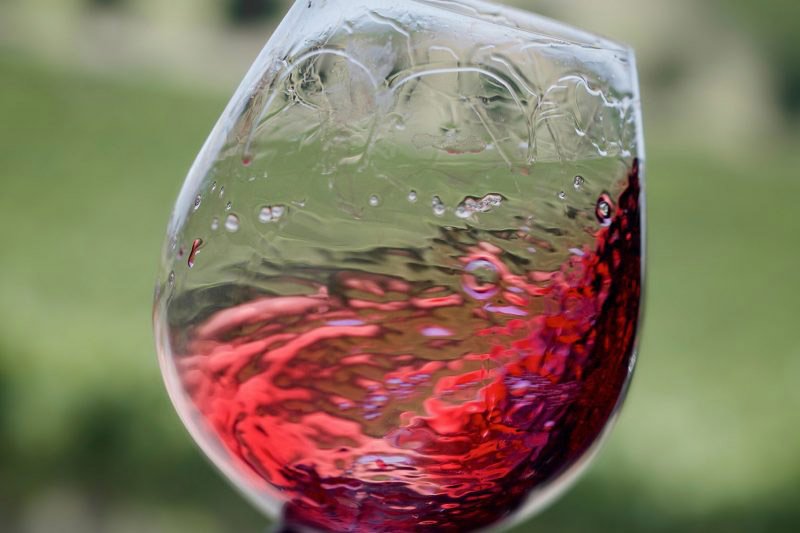
Here’s how much time you should decant your favorite red wine:
Wine Style: Time to Decant
- Madeira: Decant 1 day for every decade of bottle age. For example, a 50 year old Madeira is best decanted for 5 days.
- Nebbiolo: 3 hours
- Barolo, Barbaresco: 3 hours
- Mourvedre: 2-3 hours
- Vintage port: 2-3 hours
- Sangiovese: 2 hours
- Syrah: 2 hours
- Cabernet Sauvignon: 2 hours
- Petite Sirah: 1-2 hours
- Tempranillo: 30–60 minutes
- Merlot: 30–60 minutes
- Pinot Noir: 30-60 minutes
- Malbec: 30–60 minutes
- Cabernet Franc: 30–60 minutes
- Grenache: 30–60 minutes
- Barbera: 30–60 minutes
- Zinfandel: 30 minutes
Next, let’s discover how to decant wine properly.
2 Classic Methods to Decant Your Wine
There are two ways of decanting your bottle of wine.
1. The Classic Decanting Process
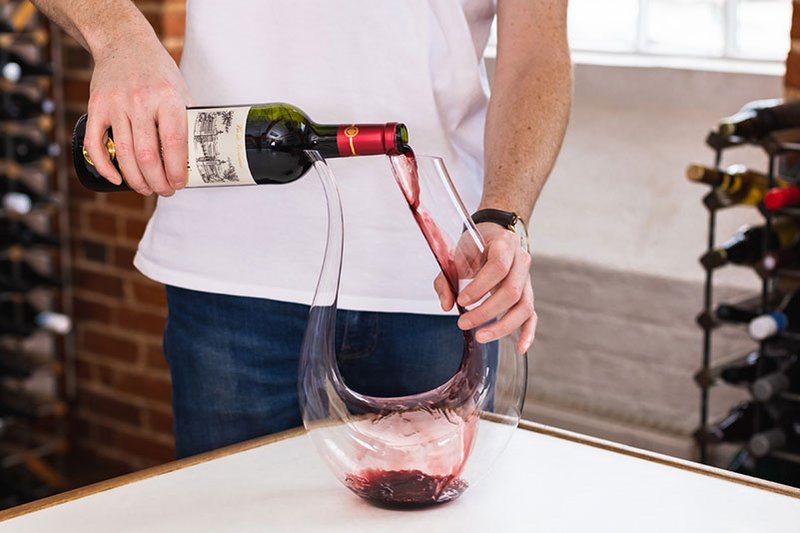
Here’s what you should do:
- Prepare your bottle at least a day before opening it. If the bottle is stored horizontally, place it vertically so all the sediment can settle to the bottom of the bottle.
- Prepare a clean glass decanter.
- Use a corkscrew to open the bottle carefully and avoid disturbing the sediment.
- Start pouring the wine into the decanter (you can also use a decanting cradle to pour more carefully.) The bottle should be tilted slightly (45° angle) to prevent the sediment from moving to the neck of the bottle.
- Pour into the decanting vessel until you see any sediment particles, dust-like specs, or if the liquid is unclear. Be especially careful if you’re dealing with an older red wine (which tends to have the most sediment.)
Place a flashlight or any other light source below the bottleneck to spot any sediment particles. This will ensure a more precise and careful decanting.
- Leave about half an ounce of the unclear wine in the bottle.
This method is great to use on an older bottle.
2. The Shock Decanting Technique
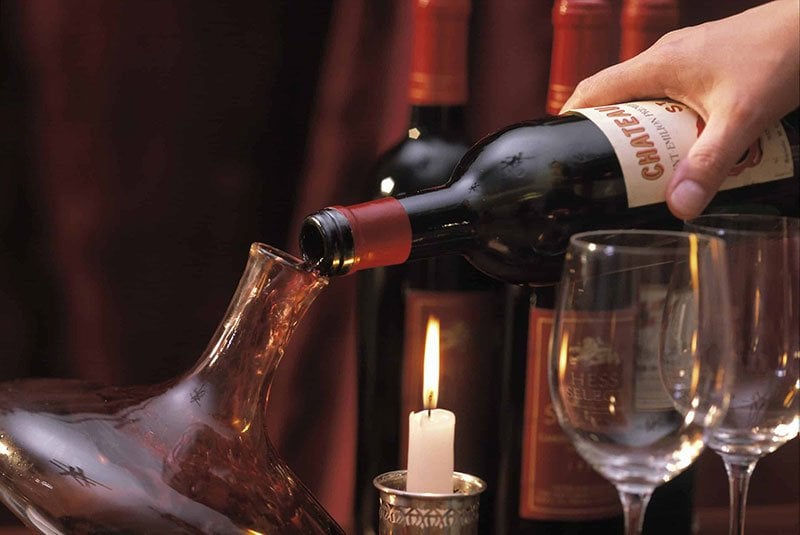
However, if you have a young vintage, you can also use the shock decanting process. You simply have to tilt the wine bottle vertically and let the wine pour with the force of gravity.
This allows for accelerated aeration of the wine and is great for fresh, tannic wines which are less than two years old. Such wines are clear and have not formed any sediments yet. Avoid using shock decanting for older vintages since their sediment will mix in with the clear liquid.
Serving Decanted Wine

Once you pour the wine into a decanter, bring it to your guests along with the empty original bottle (unless you decide to double decant.)
This way, everyone can take a look at the wine label and see what they’re drinking.
Saving the cork or having a stopper is also helpful if there is some leftover wine you want to pour back in the bottle and store for later.
But how do you clean your wine decanter after the party is over?
How to Clean Your Glass Decanter
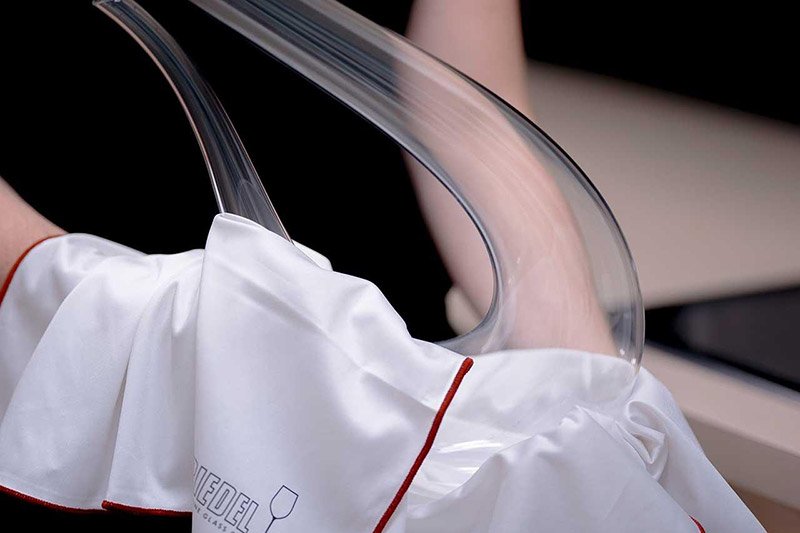
Wine decanters have beautiful curvy shapes, and that’s precisely what makes them hard to clean.
Their shape also retains the soapy water inside, which might change the flavor of the next wine you pour in. That’s why it’s better to avoid using any cleaning detergents.
The best way to clean your glass or crystal decanter is by simply soaking it in hot water and rinsing it to remove any remaining stains. If you still struggle with stubborn stains, try cleaning the vessel with stainless steel beads to reach all the problematic spots.
The most effective way to dry your decanter is by putting it on a decanter dryer to avoid getting any water drop marks on the glassware.
So, can you decant wine without a wine decanter?
Decanting Without a Wine Decanter

You can easily decant wine without a decanter.
Here are a few ways to do that:
- Use your wine glass: Swirling your wine in the glass is an effective and easy way to accelerate the oxidation process.
- Use a carafe: All you need to do is to pour the wine into another vessel so it can breathe. So, if you don’t have a wine decanter, a glass carafe will do the same job and enhance the wine’s aroma.
- Use a wine aerator: A wine aerator (like the Venturi wine aerator) is a little device through which you pour the wine into your wine glass. When the wine goes through the aerator, it is exposed to a stream of oxygen which increases its contact with the air.
- Use a blender: Blending wine might sound like taboo to most wine lovers. Even though it is not the most careful decanting method, it works surprisingly well.
If you have a cheap younger wine, just throw it in the blender for 10-15 seconds, and you will get perfectly aerated wine in no time.
Now that we’ve cleared the air about decanting wine, how about buying some fine wine bottles for your next dinner party (whether they need decanting or not!)?
You might easily get your favorite everyday wines in your neighborhood wine store.
But, if you want the more collectible, investment-grade bottles, they won’t be available in your local wine shop. And if you intend to buy wine online, be careful not to encounter a counterfeit bottle.
With Vinovest, however, you can get some of the rarest and finest vintages in the world, easily.
Buy the Best Wines for Your Collection Through Vinovest

Vinovest is a leading wine investment company that buys, authenticates, stores, and sells your wines for you.
After you sign up on Vinovest’s AI-based platform, you can take advantage of benefits like:
- Buying fine wine from all over the world at the best possible prices.
- Storing your wines in bonded warehouses under optimal conditions without having to invest in a costly wine cellar.
- Getting only original wine bottles since the Vinovest wine expert team checks each bottle’s provenance and authenticity before you make a purchase.
- Receiving guidance and help on every step of building a winning wine portfolio. Vinovest’s wine expert team of master sommelier and data scientists ensures only high-performing wines are added to your collection.
- Benefiting from significant tax advantages since the storing facilities are not charged with VAT or excise duty.
- Having some of the lowest annual fees of 2.5%, which cover all costs from buying, selling, and storing your wines, to fraud detection, insurance, and portfolio management. (This goes down to 1.9% for portfolios exceeding $50,000.)
- Getting your wines delivered to your doorstep, as a gift to your wine lovers friends, or a buyer, no matter the location.
Master the Art of Decanting As You Build a Wine Collection!

Decanting is part of the wine serving ritual that’ll elevate your wine drinking experience.
Elegant glass decanters and the clear wine in them - with intense colors from ruby-red to golden yellow - are also a sight to behold for any wine enthusiast! Additionally, decanting brings out the subtle flavors and aroma compounds that otherwise stay hidden in the bottle.
And, if you’re a wine lover looking to add some marvelous wines to your wine collection or you want to buy some fine vintages for your next big celebration, Vinovest is there to help.
Just sign up and start exploring the endless options ahead of you!



